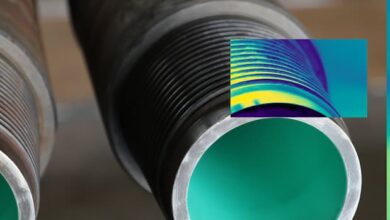Oxy overcomes Delaware Basin challenges, doubles footage per day with advanced rigs, optimized well plans and drilling practices
Technical, operational enhancements have helped to overcome challenges associated with washout, lost circulation and hard and interbedded formations
By Kelli Ainsworth Robinson, Associate Editor

Adjustments in well design, drilling practices and fluid strategy have allowed Occidental Petroleum Corp (Oxy) to more than double its feet-per-day drilled in the New Mexico Delaware Basin over a five-year period from 2012 to 2017.
Diego Tellez, Drilling Engineering Supervisor for Oxy, explained in a presentation at the 2018 IADC/SPE Drilling Conference on 7 March in Fort Worth, Texas, the strategies that Oxy has undertaken since it began drilling horizontal wells in the basin in 2012. “Using a rotary steerable system (RSS) on intermediate and lateral sections while keeping motors in the curves, identifying direct and indirect emulsion fluids as the fluids of choice, using advanced drilling rigs on multiwell pads, and a robust QA/QC program to minimize the number of tool failures has allowed us to achieve this performance improvement in drilling,” he said.
The Delaware Basin offer good returns, but at the same time drilling in the Permian subplay also presents significant technical challenges. The Salado and Castile formations in the Delaware Basin, which are located just below the surface casing, contain halite and anhydrite salt layers. “It’s prone to washout, so it has to be drilled with a saturated fluid,” Mr Tellez said.
Moving deeper, the Bell Canyon, Cherry Canyon and Brushy Canyon formations of the Delaware Mountain group are all highly interbedded. The Bell Canyon was one of the first producing formations in the area, dating back to the 1950s, and is now depleted and subject to an injection and water disposal program. “Nowadays, it’s a water flow hazard,” Mr Tellez noted. The Cherry and Brushy Canyon formations have also been developed in decades past and are now depleted. Severe lost circulation can be encountered in both formations.
Further down, the Bone Spring group and the Wolfcamp, which are both targeted for horizontal drilling, consist of hard limestones and shales interbedded with limestones and sandstones.
Besides geological challenges, operators in the basin also must contend with US Bureau of Land Management (BLM) regulations, which can create delays and logistical hurdles. “A key distinction of New Mexico drilling, compared to other unconventional areas, is that most of the wells that were drilled in this case history were drilled in federally owned land, which is administered by the BLM,” Mr Tellez said. This means operators in the area are subject to additional regulations and must obtain permits from the BLM – which can take from six to nine months to receive. Oxy was able to mitigate some of these challenges by moving to pad drilling.
This article discusses a case study of 179 wells drilled between 2012 and 2017 in the Delaware Basin in southeastern New Mexico. The vertical depth of the wells studied ranged from approximately 5,000 ft to 12,000 ft. Lateral lengths ranged from 3,000 ft to 10,000 ft. Between 2012 and 2015, the true vertical depth of most of the horizontal wells Oxy drilled ranged from 4,000 to 9,000 ft. The TVD of most wells drilled since 2016 has been between 8,000 to 10,500 ft.
Evolving approach
Well and fluid designs
In 2016, Oxy introduced a new well design to combat water flows and lost circulation. The previous design, used from 2012 to 2015, consisted of a surface section with a 14 ¼-in. hole and 11 ¾-in. casing, an intermediate section with a 10 5/8-in. hole and 8 5/8-in. casing, and a production section with a 7 7/8-in. hole and a 5 ½-in. casing string. “The disadvantage of this design was that we had to deal with water flows while we’re trying to drill the curve and lateral,” Mr Tellez said. Additionally, Oxy was unable to use an RSS in the 7 7/8-in. lateral section due to the hole size.
To address these challenges, Oxy decided to set the intermediate casing deeper, about 100 ft above the kick-off point for the curve. The new design for wells with lateral lengths of up to 7,500 ft consists of a 14 ¾-in. hole and 10 ¾-in. casing in the surface section, a 9 7/8-in. hole and 7 7/8-in. casing in the intermediate section and a 6 ¾-in. hole with 5 ½-in. by 4 ½-in. tapered casing in the production section. The new design enables the use of an RSS in the lateral section and removes the challenges of water flows and lost circulation from the curve and lateral portions. However, the trade-off is that part of the intermediate section is now exposed to the water flow and lost circulation zones below it, “so the key is managing the drilling fluid strategy,” Mr Tellez said.
For laterals longer than 7,500 ft, a separate design was required to manage high equivalent circulating densities, as well as torque and drag. Under this design, the surface section is widened to a 17 ½-in. hole with 13 5/8-in. casing, the intermediate section consists of a 12 ¼-in. hole and 9 3/8-in. casing, and the production section comprises an 8 ½-in. hole with 5 ½-in. casing.
In 2017, to combat water flows and lost circulation, Oxy began using a direct emulsion water-based mud in the vertical section of the well, Mr Tellez said. The mud uses saturated sodium chloride (NaCl) brine for its external phase, which helps the operator to avoid washout. Emulsified diesel is used for the mud’s internal phase, which lowers the density of the fluid and helps mitigate lost circulation. In the curve section, an invert emulsion oil-based mud is used to reduce torque and drag and raise the rate of penetration (ROP).
Initially, saturated and diluted, or cut, NaCl brines were used in the vertical and lateral sections. However, nonproductive time often occurred due to exposure to high-pressure water flow zones and depleted formations. In 2015, the operator deepened the intermediate casing in order to isolate the depleted sands from the curve and lateral sections.
A new fluid strategy was also adopted, which consisted of a mixed-metal hydroxide (MMH) for the vertical section and an invert emulsion OBM for the laterals. While the MMH helped reduce salt washout and lost circulation, particularly through the Brushy Canyon formation, Mr Tellez said, it required special disposal.
“The main disadvantage of the MMH system was that excessive dilution, known in the field as dump and dilute, is required to maintain your densities, and excessive waste management costs are incurred.” The operator adopted its current fluid strategy to manage lost circulation, washout and water flows in the intermediate section of the well without the costs associated with the MMH mud.
New drilling practices, BHAs
The operator’s drilling practices have also been evolving. Oxy has optimized its BHA designs by moving from steerable motors to rotary steerables in the vertical and lateral sections of its Delaware Basin wells, and has collaborated with service providers to design bits that help manage vibration, offer improved toolface control and increased durability.
In the intermediate section, “managing vibrations is key for drilling performance,” Mr Tellez said, particularly stick-slip and torsional vibrations. For this section of the well, the operator needed a bit that would be able to drill in the range of formations and rock types in the Delaware Basin without sustaining vibration damage.
The bit design chosen was a 9 7/8-in. bit with six blades set with 16-mm cutters and an 8-in. tapered gauge. It has depth-of-cut (DOC) control components set in the cone. This bit design achieved a best run of 6,863 ft for an overall ROP of 170 ft/hr on a motorized RSS BHA. Utilizing an RSS, rather than a steerable motor, has allowed Oxy to reduce torsional harmonics and increase ROP in the intermediate section by 64%. The switch has also helped reduce the average number of bits required for this section from 2.0 to 1.1.
While Oxy briefly used an RSS for the curve section in the Delaware Basin in 2015 and 2016, the company found that the RSS that allowed them to achieve a high build rate in the curves did not perform well in the laterals. This necessitated a trip to attach a new BHA for the lateral section. Additionally, an RSS could not be used to drill out stage cementing tools.
“We wanted to eliminate the stage tool cleanout run … but we also found that motors were more predictable and less prone to failures when drilling curve sections. So our typical BHA nowadays has a high-speed motor for better toolface control,” Mr Tellez said. Switching from an RSS to a steerable motor for the curve section has helped Oxy reduce BHA runs by 40% in 6 ¾-in. holes in Q2 and Q3 of 2017, compared with the average numbers in 2015 and 2016 using an RSS. However, it remains a goal to drill the curve and lateral sections with a single BHA, he noted.
As laterals in the Delaware Basin get longer, the operator’s chief concern in this section is bit and BHA durability. In 2015, Oxy began using a push-the-bit RSS in the lateral section, as the increased friction in laterals can make it challenging for a steerable motor to achieve the necessary weight-on-bit while sliding. Drilling with an RSS allows the drill string to be rotated, which can break the friction. For the lateral section, Oxy uses an 8 ½-in. bit with six blades set with 16-mm cutters and backup cutters on the shoulder to minimize bit damage. Using this bit and RSS combination, Oxy has achieved a best lateral performance of 9,751 ft drilled in 59.5 hours.
Move to pad drilling
Moving to pad drilling has also helped the operator to reduce drilling time in the Delaware Basin. From 2012 to 2014, most of the wells in the case study were drilled on single well pads. By 2017, the majority of wells were drilled on multiwell pads, with 30 to 35 ft of space between wellheads, Mr Tellez said. Oxy saw its rig move time decrease by 80% following this shift.
The shift to multiwell pads has also helped the operator better comply with BLM regulations and, thus, reduce permit complexity, he added. “The move to well pads was a natural conclusion because you want to minimize surface disturbance, particularly when drilling on federally owned lands.”
Additionally, because the BLM requires operators to wait on cement for one section of the well before drilling the next, “by having multiwell pads, you can skid and drill your next well while the previous well is waiting on cement,” Mr Tellez said.
The upgrades and improvements contractors have made to their rigs have also contributed faster and more efficient drilling. Utilizing these high-spec, modern drilling rigs has helped Oxy improve its drilling performance in the Delaware Basin. The rigs used to drill the 179 wells studied were all AC rigs with 7,500-psi circulating systems and skidding systems. Many of the rigs had three mud pumps. Two of the rigs used had been upgraded with increased setback capacity that allowed them to hold 23,000 lb of 5 ½-in. drill pipe. Additionally, many of the rigs used had some level of automation, Mr Tellez said, including automated stick-slip control and drillstring rocking.
New quality control measures
To reduce downhole tool failures, Oxy implemented a new QA/QC initiative during the study period. In 2013, the company conducted audits of its contractors and vendors and identified deficiencies that were limiting tool performance. Based on these findings, the operator developed a set of standard operation requirements for non-complex tools.
These requirements define minimum QA/QC standards, reporting requirements and personnel qualifications, all based on industry standard and best practices. When failures do occur, they’re examined by a root cause analysis team, which provides a monthly summary of failures to identify needed improvements from vendors. Using this approach, the operator saw the number of failures per 10,000 ft drilled fall throughout 2017. By August, the company saw an average of only one failure per 10,000 ft.
For more complex equipment – including motors, RSS and measurement-while-drilling and logging-while-drilling systems – vendors are required to submit a tool inspection plan. This plan provides step-by-step instructions for calibration, inspection, assembly, testing and failure analysis. “We have a third-party inspector audit that tool against these standards, and if it’s not compliant, then we don’t accept that tool,” Mr Tellez said. DC
For more information about this project, please see IADC/SPE 189597, “Unconventional Drilling in the New Mexico Delaware Basin Case History,” presented at the 2018 IADC/SPE Drilling Conference, 6-8 March, Fort Worth, Texas.




